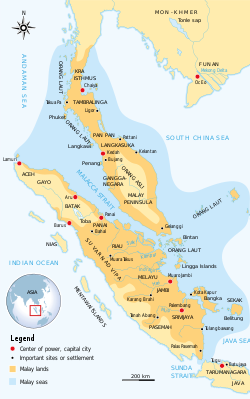Our website is made possible by displaying online advertisements to our visitors.
Please consider supporting us by disabling your ad blocker.
Melayu Kingdom
Melayu Kingdom | |||||||||||||
|---|---|---|---|---|---|---|---|---|---|---|---|---|---|
| before 671–692 1028–1347 | |||||||||||||
 Map of ancient Melayu realm, based on a popular theory that Malayu Kingdom relates with Jambi | |||||||||||||
| Capital | Minanga Dharmasraya Pagaruyung | ||||||||||||
| Common languages | Old Malay, Sanskrit | ||||||||||||
| Religion | Buddhism, Hinduism | ||||||||||||
| Government | Monarchy | ||||||||||||
| Maharaja | |||||||||||||
• 1183 | Trailokyaraja | ||||||||||||
• 1286 – 1316 | Tribhuwanaraja | ||||||||||||
• 1316 – 1347 | Akarendrawarman | ||||||||||||
| History | |||||||||||||
• Earliest mention | 671 | ||||||||||||
• Annexed by Srivijaya | 692 | ||||||||||||
• Independence restored | 1028 | ||||||||||||
• Affiliated with Majapahit | 1347 | ||||||||||||
| Currency | Gold and silver coins | ||||||||||||
| |||||||||||||
| Today part of | |||||||||||||
| History of Indonesia |
|---|
 |
| Timeline |
|
|
| History of Malaysia |
|---|
 |
|
|
The Melayu Kingdom (also known as Malayu, Dharmasraya Kingdom or the Jambi Kingdom; Chinese: 末羅瑜國; pinyin: Mòluóyú Guó, reconstructed Middle Chinese pronunciation mat-la-yu kwok)[1][2][3] was a classical Buddhist kingdom located in what is now the Indonesian province of West Sumatra and Jambi.
The primary sources for much of the information on the kingdom are the New History of the Tang, and the memoirs of the Chinese Buddhist monk Yijing who visited in 671. The state was "absorbed" by Srivijaya by 692, but had "broken away" by the end of the 12th century according to Zhao Rukuo.[4] The exact location of the kingdom is the subject of study among historians. One theory is that the kingdom was established around present-day Jambi on Sumatra, Indonesia, approximately 300 km north of Palembang. According to this theory, it was founded by ethnic groups in the Batanghari river area and gold traders from the Minangkabau hinterland of Pagarruyung.[5]
- ^ Muljana, Slamet , (2006), Sriwijaya, Yogyakarta: LKIS, ISBN 979-8451-62-7.
- ^ I-Tsing (2000). A Record of the Buddhist Religion As Practised in India and the Malay Archipelago (A.D. 671–695). Translated by Takakusu, Junjiro. Asian Educational Services. pp. xl–xlvi. ISBN 978-81-206-1622-6.
- ^ Reid, Anthony (2001). "Understanding Melayu (Malay) as a Source of Diverse Modern Identities". Journal of Southeast Asian Studies. 32 (3): 295–313. doi:10.1017/S0022463401000157. PMID 19192500.
- ^ Coedès, George (1968). Walter F. Vella (ed.). The Indianized States of Southeast Asia. trans.Susan Brown Cowing. University of Hawaii Press. pp. 79–80, 83, 142, 179, 184. ISBN 978-0-8248-0368-1.
- ^ Munoz, Paul Michel (2006). Early Kingdoms of the Indonesian Archipelago and the Malay Peninsula.
Previous Page Next Page


